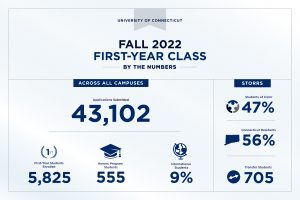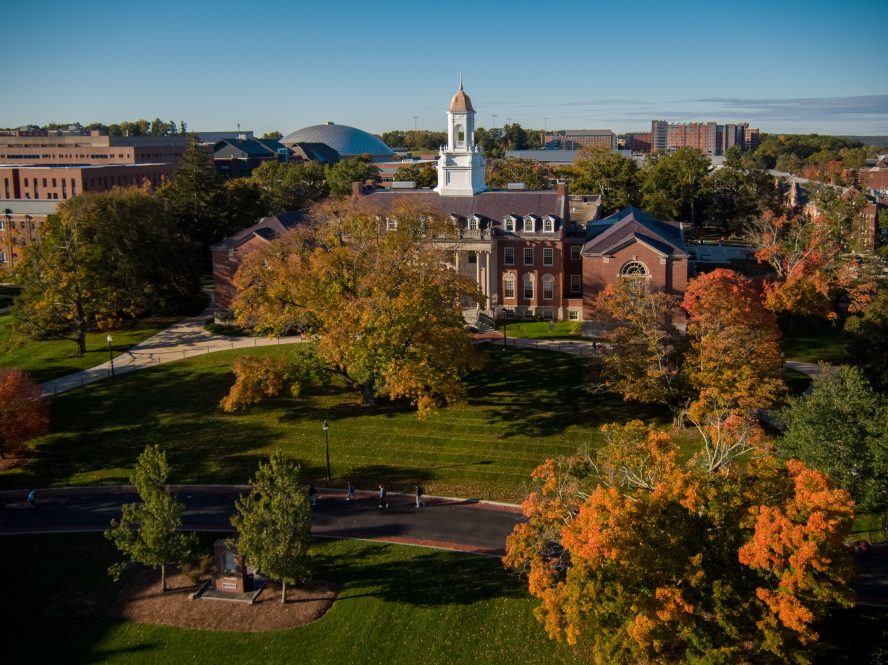Among UConn’s Class of 2026, more than one-quarter are starting a new tradition as the first generation in their families to attend college. About 175 of the incoming students led their classes as valedictorians or salutatorians. And a record number come from underrepresented backgrounds, helping UConn reflect the diverse tapestry of its state and nation.
They’re all among an outstanding class of more than 5,800 incoming first-year students at UConn’s campuses statewide, including a record of 4,075 at Storrs.
First-year Storrs students move into their residence halls starting Friday, followed over the weekend by returning and transfer students, and all Stamford residential students. Fall semester classes begin Monday.
The 4,075 first-year students enrolling at Storrs will be joined by almost 1,750 at the regional campuses in Hartford, Stamford, Waterbury, and Avery Point.
Even before their first fall semester class, they’ve already proven themselves: They faced stiff competition in the record-high pool of more than 43,000 applicants, including about 41,000 specifically seeking spots in Storrs.
The University will also welcome about 705 students transferring to Storrs this fall from other colleges and universities, and around 210 transferring from other institutions to the regional campuses.
All of the enrollment figures are preliminary, with final numbers determined on the semester’s 10th day.
The Most Diverse Class in UConn History
About 26.5% of the incoming first-year Storrs students come from races or ethnicities that are traditionally underrepresented in higher education, a category that includes Black, Hispanic/LatinX, Hawaiian/Pacific Islander, American Indian, and Alaska native students.
That’s a record high for UConn, as is the 47% of newcomers who are students of color, a category that includes the underrepresented students along with Asian populations.
About 30% of members of the Class of 2026 have personal or family incomes that qualify them for federal Pell Grant aid. That’s an increase from 22% in 2010, and an indicator that UConn is succeeding in its commitment to providing access to talented students regardless of their financial circumstances.
“UConn is experiencing great success in attracting outstanding students from increasingly diverse backgrounds,” says Nathan Fuerst, UConn’s vice president for enrollment planning and management. “Students are drawn to the high-quality education through innovative academic programs and the vibrant undergraduate experience, which drives them toward success during their time at UConn and in their careers.”
About 27.5% of incoming Storrs first-year students are the first generation in their families to attend college. They include Kaleb Jennings ’26 (CLAS), who jump-started his college career by participating in UConn’s Student Support Services summer enrichment program.
“It was a great opportunity, and did help give an idea of what the college life is like. It provided a head start from my peers and was an experience that I will continue to look back on as college continues,” says Jennings, a Groton native who plans to double-major in journalism and digital media design.
Jennings, whose goal is to be a professional sports team’s photographer, has already taken steps toward that goal by securing a spot taking photos for UConn Football. Having selected UConn because of its networking and academic opportunities, he’s tasting success even before stepping foot into his first fall semester class as a first-generation student.
“My family is excited and relieved that I am attending UConn. It gives them a sense that I will be surely successful in my future,” he says.
Jennings is part of a highly talented incoming class that includes 82 valedictorians and 93 salutatorians, about 85% of whom come from Connecticut high schools. The class also includes 555 first-year students whose achievements earned them a spot in the highly competitive Honors Program.
Although the majority of students return this weekend, many first-year students like Jennings participated in the summer SSS program or other initiatives to help them prepare for the next stage of their academic life and settle into campus.

Preparing for Success at UConn
For incoming student Eben Yobo, picking UConn was an easy decision. Drawn by its computer engineering program and the chance to experience life beyond his New Jersey hometown, Yobo aspires to start a software engineering / search firm after college that would challenge companies like Google and Microsoft.
He wasn’t initially enthused about spending part of his last summer before college in a classroom. But after participating in the UConn School of Engineering’s Summer BRIDGE Program, he says the lessons he learned will be valuable throughout his time at UConn.
“As I’ve gone through and graduated BRIDGE, I now truly see the effect and importance of it,” Yobo ’26 (ENG) says of the program, which is offered by the Vergano Institute for Inclusion as an intensive five-week program to help students from underrepresented backgrounds prepare for the rigors of the engineering curriculum.
“BRIDGE taught me many valuable lessons that I will utilize during the semester,” Yobo says. “(It) taught me to value everyone that comes my way and to be flexible and understanding with people. Building a community is not easy, but with the collaboration of others, it is possible.”
He’ll have many peers with whom to build community: Overall, UConn will have about 6,740 new undergraduates among the first year and transfer students, and expects to have about 18,800 total undergraduates on the Storrs campus.
Including the regional campuses, the total undergraduate student body will be about 23,750.
Lyvia Baence ’26 (ENG), who also completed the BRIDGE program with Yobo and others, will be among students starting at UConn Stamford, a campus she selected because it was close to her Bridgeport home but still offered everything she wants in a college experience, including a diverse student body.
“UConn has always amazed me with how inclusive they are and how they show interest in diversity. It’s nice to know that they care about being more inclusive in their programs and that if you work hard, you can become successful,” said Baence, who plans to design apps and create websites for a tech company after graduation, and potentially continue to graduate school.
About 56% of the Storrs first-year students are Connecticut residents; overall, with regional campuses included, almost 68% of the first-year students hail from in-state. They come from 158 of the state’s 169 towns and cities, and from 42 states and 38 countries.
As pandemic-related travel complications eased, interest has remained strong among out-of-state residents and has started to rebound among international residents.
About 34% of the incoming first-year Storrs students are from other states, the same percentage as in 2021; and about 9% are from other nations, up from 6% last year and returning to normal pre-pandemic levels.
The overall UConn undergraduate student body will comprise about 75% from Connecticut, in the same range as recent years, and in the range that’s expected to continue moving forward.
How to Build an Amazing Cohort of Students
The Class of 2026 is the second cohort accepted under the test-optional application process that UConn announced in spring 2020, which it has extended for three more years to continue its assessment.
Under that pilot program, students can submit their SAT or ACT standardized test scores with their UConn applications if they wish, but are not penalized or disadvantaged if they choose not to.
UConn already uses a holistic application review process in which no single piece of an application, including standardized test scores, would be the make-or-break factor considered for an offer of enrollment.
As was the case with the previous class, a large number of those in the Class of 2026 – about 65% — opted not to submit standardized test scores with their applications.
UConn had already been considering whether to pilot a test-optional process before COVID-19 emerged in 2020. However, the pandemic added impetus by exacerbating the underlying equity issues, since high school students had varying access to e-learning, preparation for the SAT and ACT, and conducive testing environments.
The three-year extension will help the University disentangle the effects of the COVID pandemic from the test-optional approach when assessing student success.
That includes following the progress of members of the Class of 2026, whose high school careers were markedly impacted by the pandemic’s complications, but whose perseverance helped them land a spot at UConn.
“We continue to focus on ways to reduce barriers to a UConn education, and our evaluation of admission applications is another example of that,” says Vern Granger, UConn’s director of undergraduate admissions.
“Our holistic review of applications is not dependent on any single factor, like a standardized test score, which provides us the opportunity to build an amazing class of students that supports our mission of embracing diversity and cultivating leadership.”



